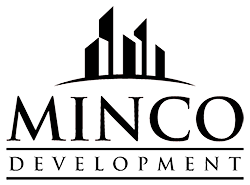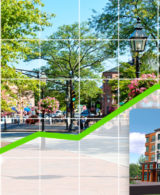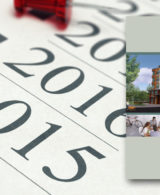The Future is Bright with Smart Growth. Learn all the Latest Details.

Imagine a different gateway to the city. The underutilized lots surrounding the MBTA Commuter Rail Station and Route 1 traffic circle have been redeveloped, generic sprawl replaced with multi-use buildings of condominiums, apartments, and businesses, all in keeping with the character of Newburyport. It’s inviting and walkable, not unlike downtown.
That is what the city for years has sought to create with the adoption of a Smart Growth District in accordance with Massachusetts General Laws, Chapter 40R. As the final City Council vote is approaching on August 10th, all question marks deserve to be straightened out. Facts should replace misinformation.
If you have followed our series of blog posts, you already know a lot about the benefits of Smart Growth. You know the details of our proposed One Boston Way, the city’s first Smart Growth development. You know how other communities have leveraged the statute. You know why city officials and business leaders stand behind the idea.
Planning Director Andy Port puts it this way:
“While the city is in its best financial position in years, continuous improvement of our schools, roadways, affordable housing, and services is something our citizens expect and deserve. When something like Smart Growth comes along it’s really a pretty unique community windfall.”
In light of recent questions and requests for additional information, we’ve gathered some key additional details that are good to bear in mind (if you want to dig even deeper into the issues, please also check out the city’s excellent overview of frequently asked questions).
A Smart Growth District will take decades to complete:
- Development, by nature, moves slowly. The adoption of a Smart Growth District will not result in a sudden construction boom around the Route 1 traffic circle. Permitting, financing, complex regulations, challenging land assemblage, and other constraints mean not all proposals come to fruition or take several decades to be realized. Land in the District is split among many owners, and occupied by several functioning businesses.
- MINCO’s One Boston Way is a proposed land sale/development agreement established with the MBTA in the fall of 2013. It features 80 apartments and 3,500 square feet of shared office space and live-work units in an underutilized parking lot off Parker Street, and is currently the only proposal on the table within the district. (It is impacted by the rules of the district if the district is approved, but is not the driving force of the Smart Growth initiative.) Further redevelopment will be gradual and subject to approval by the Planning Board. Any development must also adhere to the design standards spelled out in the Smart Growth ordinance.
- In other words, the city will not see a great influx of new residents in just a few years. Moreover, although theoretical buildout of the proposed District is estimated at 540 dwelling units, the city’s Office of Planning & Development has determined 400 new units – mostly one to two-bedrooms – to be a more realistic figure due to, for example, wetlands constraints and the small size of most parcels.
Newburyport Public Schools can accommodate new students who move into the Smart Growth District:
- If the Smart Growth District were to eventually result in the theoretical maximum of 540 units, the city estimates about 155 school-aged children would live there. This figure has some concerned it would require the construction of a new school building. Given the unlikelihood of the District’s reaching as many as 540 units, the 155-estimate is probably high, but even so, the concerns are unfounded. Enrollment projections from the School Department show a district-wide decline in the number of students starting in the younger grades, a trend that will affect the higher grades in the coming years.
Superintendent Susan Viccaro says:
“I have reviewed the data on 40R and its potential impact on the Newburyport Public Schools enrollment. I do not believe that there will be any negative impact on enrollment as we look to the foreseeable future. I still have room in all buildings and our class sizes are currently good. We are opening Choice in kindergarten next year…The plan will be to continue to open the next grade level as enrollment is declining at the younger grades and appears to be the start of a state trend.”
- Under Chapter 40S, a companion statute to Chapter 40R, the state is obligated to cover any net increase in cost of educating new students who move into a 40R District that is not offset by a net increase in property tax revenues. It’s worth noting that although more than 30 municipalities in the Commonwealth have adopted Smart Growth Districts since their inception in 2004, only three (Lunenburg, Lakeville, and Chelsea) have ever applied for 40S reimbursements.
A Smart Growth District will not have a noticeable impact on city services:
- The city’s Water and Wastewater Treatment Plant has sufficient capacity to serve additional residents and commercial growth within the 40R District, according to the city’s Department of Public Services. The city completed extensive upgrades to both plants in recent years, ensuring ample capacity.
- The challenge for this entire portion of the city is pumping untreated sewage over the ridge of High Street down to the treatment plant on Water Street. The Graf Road Lift Station is currently handling sewer flows far in excess of its designed capacity, and it will need to be upgraded regardless of the fate of the Smart Growth District. The creation of the District would, on the other hand, give the city’s application for a “MassWorks Infrastructure Grant” a tremendous boost since the state seeks to direct funding toward compact, transit-oriented neighborhoods with the potential for nearby job creation.
- Since the city and state already conduct snow removal and routine maintenance of all roads that serve the proposed Smart Growth District, the cost for those services is expected to remain the same. Any snow removal and maintenance needed on private property, as well as trash and recycling pickup will, as always, be the responsibility of the land owner.
- An increase in demand for emergency response services is anticipated to be incremental and small, considering that even at full buildout the 40R District would contain less than 5 percent of Newburyport’s housing stock. Net additional property tax revenues in the District should offset marginal additional costs for fire, police, and ambulance calls. The land owned by the MBTA, in fact, currently generates no property taxes at all.
- A financial analysis prepared by the city’s Finance Department and its Office of Planning & Development indicates that at the theoretical full buildout of 540 units the District will generate approximately $660,000 annually in new property taxes. Even if only half as many dwelling units were built, the city would see a net gain of approximately $260,000 per year.
Current roadways can handle the projected new growth:
- Existing roadways have been determined to have enough capacity to support even the theoretical maximum buildout within the Smart Growth District. Still, the City is collaborating with the Merrimack Valley Planning Commission and state’s Department of Transportation on options to modify the design of the Rte. 1 Corridor. By shrinking the rotary, for example, the area would become more pedestrian- and bike friendly.
- The notion of Smart Growth was conceived precisely to counteract the impact of urban sprawl: too many cars, and too much infrastructure, serving too few people, inefficiently. As stated on the city’s website:
“In the past two decades a nation-wide trend has returned to ‘neo-traditional’ development patterns, based upon infill and redevelopment of areas like the proposed 40R District, where residents are looking for alternative access to work and play, and less dependence on vehicle trips and miles traveled. It is this growing segment of the population that will be attracted to the 40R District.”
Our elected officials and residents of this community have over and over expressed their support for the creation of a Smart Growth District. It is time Newburyport realizes that goal, spelled out in the 2001 Master Plan, the 2004 Strategic Land Use Plan, and the 2014 Master Plan draft.
Why? As other municipalities have discovered, Smart Growth delivers a myriad of benefits. In Newburyport’s case, it turns an underutilized area into a revitalized tax base for the city. It represents your chance to transform a wasted asset – the commuter rail station that the city was fortunate to get in the late 1990s – into a hub of personal, recreational and economic activity.
Newburyport’s Finance Director and City Auditor, Ethan Manning, concludes,
“The city’s recent credit rating upgrade to AAA by Standard & Poor’s marked an important milestone. Additional motor vehicle excise taxes, local meals and room taxes, licenses, permits, and parking fees continue to supplant property taxes as a main source of income. And the city is committed to continuing to diversify its revenue sources and expanding the tax base. Both of which Smart Growth provides.”



